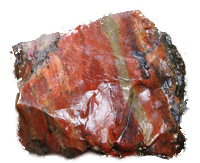![]()
![]()
Throughout the Black Rock area in Nevada one finds every conceivable rock you can think of. Just about all of us have no idea what we are looking at. Our rock collecting is picking up "monkey rocks', those shiny or neat looking peices everywhere. In reality we come across all sorts of interesting things we actually take for granite -granted. This glossary defines many of the rocks we find with accurate descriptions and sometimes photos. Most of these rocks have crystal formations associated with them; which we do not cover. It is not intended to be a Geology Lesson.
A-C • D-F • G-I • J-L • M-O • P-R • S-U • V-X • Y-Z
JASPER - is an opaque form of Chalcedony, which is a microcrystalline variety of the mineral Quartz. It often contains an abundance of impurities, and therefore some regard it as a rock instead of a mineral. Jasper is usually associated with brown, yellow, or reddish colors, but may be used to describe other opaque colors of Chalcedony such as dark or mottled brown, yellow, orange, red, green, and rarely blue. The common red color is due to iron inclusions. It is lso refer to any form of opaque Chalcedony in all colors. Jasper is usually multicolored or banded. While some forms of Jasper are banded, these banded Jaspers may appear similar to Agate, but unlike Agate they are opaque. Patterns in jasper arise during the consolidation process forming flow and depositional patterns in the original silica rich sediment or volcanic ash. Hydrothermal circulation is generally thought to be required in the formation of jasper.When Jasper is dull and lacking interesting colors or patterns, it is not Jasper but rather Chert. |
 |
